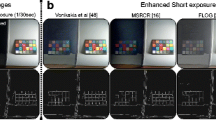Abstract
For intensity correction under illumination changes in video sequence, one of the main problems lies in the lack of adaptive technique for the classification of stationary and non-stationary pixels in the images. In this paper, we propose an efficient estimation approach for intensity factor of illumination changes in order to perform intensity correction for dynamic sequence images. Firstly, the ratio image is obtained, where the probability density function computed on pixel values can be considered as a mixture Gaussian model. Then the process of the parameter estimations is performed based on Expectation–maximization (EM) algorithm. Under the assumption of Gaussian distribution for the values of stationary pixels, the intensity factor can be estimated by using pixels adjacent to the mean value of Gaussian distribution related to the stationary class. Finally, two experiments are carried out to verify the proposed method.











Similar content being viewed by others
References
Aach T, Mester R (2001) Dumbgen L Bayesian illumination invariant change detection using a total least squares test statistic. In: In 18e Colloque GRETSI, Toulouse, France, 2001.9
Black MJ, Fleet DJ, Yacoob Y (2000) Robustly estimating changes in image appearance. Comput Vis Image Und 78(1):8–31. doi:10.1006/cviu.1999.0825
Celik T (2010) A Bayesian approach to unsupervised multiscale change detection in synthetic aperture radar images. Signal Process 90(5):1471–1485. doi:10.1016/j.sigpro.2009.10.018
Dai XL, Khorram S (1998) The effects of image misregistration on the accuracy of remotely sensed change detection. Ieee T Geosci Remote 36(5):1566–1577
Dempster BAP, Laird NM, Rubin DB (1977) Maximum likelihood from incomplete data via the EM algorithm. Journal of the Royal Statistical Society: Series B 39(1):1–38
Kim YH, Martinez AM, Kak AC (2005) Robust motion estimation under varying illumination. Image Vision Comput 23(4):365–375. doi:10.1016/j.imavis.2004.05.010
Lillestr RL (1972) Techniques for change detection. Ieee T Comput C 21(7):654–659. doi:10.1109/t-c.1972.223570
Negahdaripour S (1998) Revised definition of optical flow: integration of radiometric and geometric cues for dynamic scene analysis. IEEE Trans Pattern Anal Mach Intell 20(9):961–979. doi:10.1109/34.713362
Odobez JM, Bouthemy P (1995) Robust multiresolution estimation of parametric motion models. J Vis Commun Image R 6(4):348–365. doi:10.1006/jvci.1995.1029
Phong BT (1975) Illumination for computer generated pictures. Commun ACM 18(6):311–317. doi:10.1145/360825.360839
Redner RA, Walker HF (1984) Mixture densities, maximum-likelihood and the EM algorithm. SIAM Rev 26(2):195–237. doi:10.1137/1026034
Sayed MS (2011) An efficient intensity correction algorithm for high definition video surveillance applications. Ieee T Circ Syst Vid 21(8)
Shulman D, Herve J-Y (1989) Regularization of discontinuous flow fields. In: Workshop on Visual Motion, 1989., Proceedings., Irvine, CA, USA
Skifstad K, Jain R (1989) Illumination independent change detection for real world image sequences. Comput Vis Graph Image Process 46(3):387–399. doi:10.1016/0734-189x(89)90039-x
Toth D, Aach T, Metzler V (2000) Illumination–invariant change detection. Paper presented at the image analysis and interpretation, 2000. Proceedings. 4th IEEE Southwest Symposium Austin, TX, USA
van Roosmalen PMB, Lagendijk RL, Biemond J (1999) Correction of intensity flicker in old film sequences. Ieee Transactions on Circuits and Systems for Video Technology 9(7):1013–1019. doi:10.1109/76.795054
Withagen PJ, Groen FCA, Schutte K (2007) CCD color camera characterization for image measurements. IEEE Transactions on Instrumentation 56(1):199–203. doi:10.1109/tim.2006.887667
Withagen PJ, Schutte K, Groen FCA (2010) Global intensity correction in dynamic scenes. Int J Comput Vision 86(1):33–47. doi:10.1007/s11263-009-0247-8
Xie BL, Ramesh V, Boult T (2004) Sudden illumination change detection using order consistency. Image Vision Comput 22(2):117–125. doi:10.1016/j.imavis.2003.07.003
Acknowledgment
This work was supported by National Nature Science Foundation of China (NSFC) under 50805023, the Special Fund of Jiangsu Province for the Transformation of Scientific and Technological Achievements under BA2010093 and the Hexa-type Elites Peak Program of Jiangsu Province under 2008144.
Author information
Authors and Affiliations
Corresponding author
Rights and permissions
About this article
Cite this article
Han, Y., Zhang, Z. An efficient estimation method for intensity factor of illumination changes. Multimed Tools Appl 72, 2619–2632 (2014). https://doi.org/10.1007/s11042-013-1521-x
Published:
Issue Date:
DOI: https://doi.org/10.1007/s11042-013-1521-x




